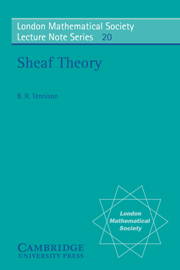Book contents
- Frontmatter
- Contents
- Introduction
- Conventions and notation
- Chapter 1 Presheaves and their stalks
- Chapter 2 Sheaves and sheaf spaces
- Chapter 3 Morphisms of sheaves and presheaves
- Chapter 4 Ringed spaces
- Chapter 5 Cohomology
- The way ahead: further reading
- References
- Hints and answers to some exercises
- Index of terminology
- Index of notation
- Frontmatter
- Contents
- Introduction
- Conventions and notation
- Chapter 1 Presheaves and their stalks
- Chapter 2 Sheaves and sheaf spaces
- Chapter 3 Morphisms of sheaves and presheaves
- Chapter 4 Ringed spaces
- Chapter 5 Cohomology
- The way ahead: further reading
- References
- Hints and answers to some exercises
- Index of terminology
- Index of notation
Summary
Sheaf theory provides a language for the discussion of geometric objects of many different kinds. At present it finds its main applications in topology and (more especially) in modern algebraic geometry, where it has been used with great success as a tool in the solution of several longstanding problems. In this course we build enough of the foundations of sheaf theory to give a broad definition of manifold, covering as special cases the algebraic geometer's schemes as well as the topological, differentiable and analytic kinds; and to define sheaf cohomology for application to such objects.
Chapters 1 and 2 cover the groundwork of presheaves and sheaves, and show that any presheaf gives rise to a sheaf in a universal way.
Chapter 3 defines the categorical viewpoint, shows that the categories of sheaves and presheaves of abelian groups on a fixed topological space are abelian, and investigates the relations between them. It also covers the processes of change of base space of a sheaf, both for the inclusion of a subspace and for a general continuous map.
Chapter 4 defines the notions of ringed space and geometric space, and gives as an example the spectrum of a commutative ring. This is proved to be a construction with a universal property among all geometric spaces. The latter are shown to be the prototypical geometric objects, by exhibiting various kinds of manifolds as special cases. The chapter also includes a discussion of Modules over ringed spaces, and the consideration of locally free Modules leads to the definition of the picard group of a ringed space.
- Type
- Chapter
- Information
- Sheaf Theory , pp. v - viPublisher: Cambridge University PressPrint publication year: 1975



